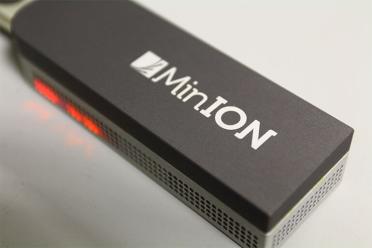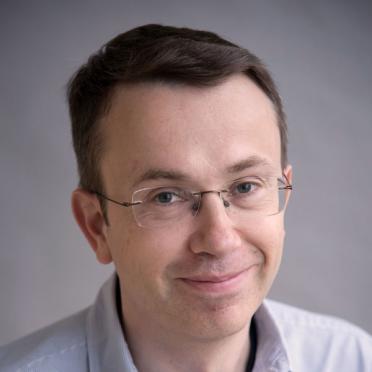Unusual routes into a science career: biohacking with the MinION
Biohacking and the MinION: revolutionising how we sequence whole genomes, open source science and increase public engagement in biology.
Earlham Institute has played an influential role in the development of the MinION, the world’s smallest, most portable and soon-to-be most important genome sequencing platform. Being affordable, that means that, unlike other high throughput platforms, MinION technology is available to a wider user base - helping us to democratise (and open-source) biology.
We asked Sebastian Cocioba, biohacker and molecular florist, about what got him into biohacking, and how he is using the MinION, among other things, to help open-source biology and to educate and equip the next generation of budding biologists.
I first met Sebastian at the Thought for Food Summit 2016 in Zurich, where we hit it off as I stumbled onto a table of plant scientists and we shared conversations about fascinating topics from engineering colour changing flowers through to setting up biology labs in bedrooms in New York.
Sebastian is one of a growing community of people who adore biology, but have had a slightly different journey into exploring the essence of life than the usual bachelor’s, master’s, PhD, postdoc route. We asked him how he became a biohacker, what he’s doing with MinIONs and next generation sequencing, among other things, and how we can help inspire, educate and equip a new generation of biologists with the tools to increase scientific literacy.
Biohacking is the tinkering and modification of biological systems through conventional and unconventional means, typically in an informal setting, such as home labs, garage labs and community hackerspaces.
I’ve always been interested in plants and have been diving deeper and deeper into the biological aspect of plants, especially floral morphology and physiology. One day I stumbled upon the concept of genetic engineering with plants and began collecting the resources and knowledge of how to do this, mainly on the internet and google forums.
As my interest grew, so too did my home lab. I collected lab equipment off eBay in various states of disrepair and taught myself a bit of electrical engineering. I fixed what seemed like a dead unit bought for $40 and brought it back to working order with a new value exceeding $2000.
After several years, I built up a fully functional genetic engineering laboratory in the 3rd bedroom of my mom’s apartment; capable of doing everything from general molecular biology to genetic engineering and recently I added Next Generation Sequencing to my lab’s wheelhouse of skills.

Imagine a world where school children sequence one of the 400,000 plant species on this planet as part of their studies and get direct scientific attribution at an early age.

I am a 26 year old college dropout with no formal degree working on various contract research projects for institutions like the MIT Media Lab and School of Visual Arts in the comfort of my home laboratory.
I am also on the board of directors for my non-profit organization, Binomica Labs, where we develop discovery-driven research-based curricula for students of middle and high school. They answer small scientific questions and get direct attribution for their work, as well as training for peer review through our internal group of established research scientists.
Our goal is to help students of all ages publish in peer reviewed journals through self-driven, novel research projects they are directly interested in. Science is the practical extension of natural human curiosity and we wish to harness this intrinsic trait through more hands-on learning focused on the generation of new knowledge.
The one I find most interesting is the Decentralized Oxalis Genome Project. We are sequencing the cosmopolitan weed Oxalis stricta as a means of developing a biohacker-driven pipeline for genomics of otherwise orphaned organisms which academia has no immediate interest in sequencing or studying.
Every participant provides a small amount of reliable sequencing data via traditional sanger sequencing based on a draft reference genome we produce in our amateur home labs. The result will be another fully sequenced plant genome and also the framework for other hackerspaces to do the same.
The ultimate goal is to get the project into the school curriculum. Imagine a world where school children sequence one of the 400,000 plant species on this planet as part of their studies and get direct scientific attribution at an early age. They can use this as an example of real world experience of independent research. Imagine applying to university (or a PhD) with three publications under your belt?
Certainly! By allowing the general public to take part in the pursuit of new knowledge we gain a collective increase in scientific literacy and can open new potential collaborations with formal institutions. The increase in generation and sharing of this new data will only reinforce the need for openness and provide future generations with an established framework for open genomics and research in general.


If you wish to make an apple pie from scratch, you must first create the universe - Carl Sagan

Since I mainly do genetic engineering research, in order to modify the organism in any meaningful way I must first have a clear map of its genetic blueprint. It would be unscientific of me to tinker in the dark and expect to generate any meaningful data without a map to guide me.
It’s the only whole genome sequencing platform I can afford that is free of any investment or initial capital contracts. Truly a personal genome sequencing device that is portable and anyone can use effectively.
The added benefit of nanopore technology is the long read capabilities. When you do not have a reference genome to align your sequence with, having the benefit of long contiguous reads can drastically decrease the computational overhead to produce genomic maps of any acceptable quality.
Due to the nature of nanopore tech, you can also sequence otherwise impossible regions of genomic DNA like centromere zones where conventional sequencing, which relies on PCR based methods, are rendered useless. Ultra long stretches of repeats are no match for the MinION so there is an abundance of added value aside from the accessibility of the device to relative novices such as myself.

It gives me a comprehensive report on not just the integrity of the data generated by the nanopore but on the sequencing run itself. This will give me vital feedback when designing my next set of nanopore experiments. The data garnered using this program makes every subsequent flow cell run better and better.
ABSOLUTELY!!!! Without these tools it would be impossible for me to conduct next generation whole genome sequencing at home. Data is useless if you can’t use it and these tools allow me to take the raw information and curate it into new knowledge.
I owe my career to the developers of these tools and wish to one day pay it forward by contributing my own set of tools for future researchers, especially those in situations similar to myself, to conduct their projects with greater efficiency and less aches of head and heart.
The largest obstacle has been the computational requirements for generating alignments of large genomic datasets using household computer systems. The RAM requirements alone would set me back tens of thousands. Luckily there are things like Amazon AWS instances which allow for rental of computing clusters, but I do deeply envy institutions with readily accessible supercomputer systems.
Hopefully with the recent upsurge in graphics cards purchased by machine learning and bitcoin mining endeavors, the price will lower and more will begin to utilize the immense parallel processing capabilities of gaming graphics cards.
Aside from computational limitations, the actual datasets generated are too big to share with my friends easily. I’d have to burn several bluray disks to transfer the near terabyte of genomic raw data from our nanopore runs.
My situation is a little unique since my focus is not on forming a startup or living forever but rather conducting good scientific research… at home! There is a quiet comfort in having your lab a mere 10 feet away from your bedroom. Those surprisingly common bursts of inspiration do not require a hour long commute to a university lab in the middle of the night. Just wake up, set up a PCR reaction, go back to bed, wake in the morning and run a gel. Days blend into one another but the ability to manipulate nature in your PJs is worth every sacrifice.

For science to become recognized as the deeply universal human activity it has always been. I wish for biohackers to commune with formal academics and for there to be no line of discrimination between the abilities of the amateur with respect to research. Credit where credit is due and a meritocracy based collaboration. I wish for science to be as commonplace as entertainment and casual hobbies.
There is so much we have yet to discover and learn about our planet and we are only beginning to scratch the surface. Biohacking can not only provide the biotech industry with feedstock for new innovations but also accademia with more leads to follow.
By essentially being the custodians of orphaned organisms, we become the first responders for conservation work, invasive species understanding, and new ideas in basic research.
By proving that we can punch above our weight, if given a chance.
By establishing precedence, we gain the trust of institutions so that opportunities can be given to anyone as long as they show passion, dedication, and perseverance despite inevitable failures and setbacks.
The public perception of science is that only the intellectual elites can generate new knowledge… which is categorically and objectively untrue.
To be literate in science one must practice science much like literacy in reading means practicing to read. As the technological and financial barriers decrease, more and more people can dive directly into research in the comfort of their homes.
My wish is to not stop at mere literacy but reach for the moonshot of global scientific eloquence.
If we are to play god, let us be responsible gods and learn to respect and understand the power each subsequent generation will have in shaping our world and beyond.
Start with a question...and let it consume your body and soul. Find a topic you are interested in and narrow it down to a question you are curious and passionate about understanding. Then, catch up on all the published literature in that respective field until you are at the bleeding edge of our understanding.
Meanwhile verse yourself in the philosophy of science as well as the theory of experimental design. Once you have all that under your belt, the next steps will be self evident. Immerse yourself in your field of interest. Reach out to authors, go to conferences, visit biohacker spaces and community labs, talk to professors of local universities...and never ever give up. Science is 99% failure so prepare your ego and steel yourself.
The knowledge and abilities that you gain along the way will serve you well in whatever new venture you embark upon… just remember that we all stand on the shoulders of giants and the only way we move forward is to teach what we’ve learned, so please pay it forward and help someone else learn something new about how you do what you do.
To prove that anyone and everyone can contribute meaningfully to the compendium of human knowledge regardless of academic background or station in life. To empower young researchers of all ages with tools and a less intimidating path toward real world contribution and discovery in an informal setting.

Earlham Institute has been at the heart in adopting the latest in next generation sequencing technology. As such, we were an early community member of the MinION Access Programme (MAP) and part of the MinION Analysis and Reference Consortium (MARC), developing essential tools and protocols for decoding the information derived from Nanopore sequencing using the MinION, such as NanoOK developed by Dr. Richard Leggett. We pride ourself in our commitment to open data and open sourcing software developed at EI, and the use of tools such as NanoOK by the greater scientific community, including biohackers, is testament to this spirit of openness in research.